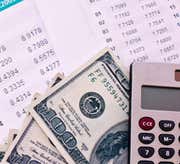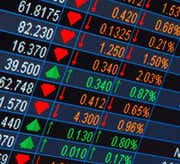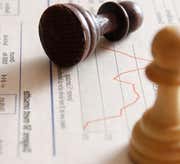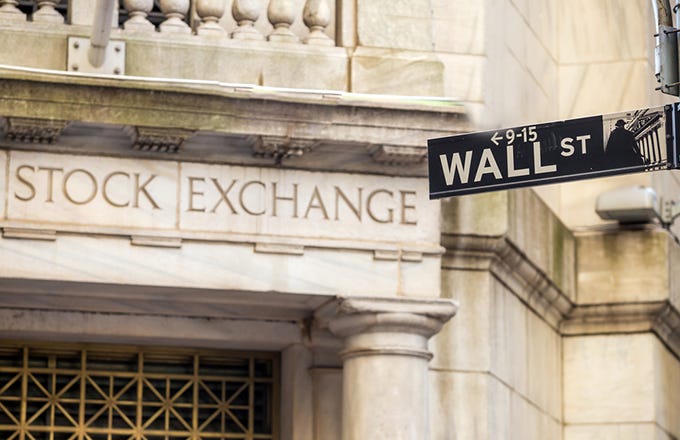Valuation models make use of volatility both as an input (statistical/historical) and as an output (implied). As we explore the difference between these two types of volatility, the reason that this is the case may become clearer. In this tutorial chapter, we’ll focus on historical volatility, also known as statistical volatility (SV). This is a measure of the volatility of the underlying stock or futures contract. It is considered known volatility because it is based on actual price changes in the underlying.
We might think of historical volatility as the rate of change of the underlying stock price. Like a car which is moving at 75 mile per hour (a rate of change per hour), a stock or futures contract also moves at a speed which can be measured as a rate as well. In the case of a stock or contract, though, this is a rate of change per year, not hour. The higher the level of historical volatility, the more that the stock has moved in recent history. Therefore, theoretically, we will also expect that stock to move in similar degrees into the future, although it’s important to remember that historical volatility does not provide insight into either trend or direction. Although there are multiple ways to calculate historical volatility, the basic underlying idea is essentially the same for each.
Historical volatility examines how quickly a stock price or future has moved in the past to predict how far it might move in the future. To return to the idea of a car traveling at 75 miles per hour, for example, we know that in a year, a car maintaining that rate of speed will have traveled 657,000 miles (75 miles per hour x 24 hours x 365 days = 657,000). In a perfect world, this is fully predictable. However, the rate of change of 75 mph may not stay the same, and it also doesn’t tell us anything about the direction of the car (if it’s going back and forth, it may not actually end up 657,000 miles from where it began). This is also true for stocks and futures, although the calculation depends on recent speeds, meaning that percentage price changes on a daily basis. If these speeds are increasing, historical volatility is generally greater.
Calculating Historical Volatility
Historical volatility is a quantifiable number which is based on past changes to the price of a stock or futures contract. To calculate it, take the past prices and price changes (from close to close), then take an average of those price changes in percentage terms. We’ll consider a real-life historical example over 10 days. When we have the average percentage price change over that 10 day period, we can then subtract the daily percentage price changes to derive deviations from the daily average change for that period.
Figure 1 includes an example which makes use of this method using IBM stock prices. It incorporates some basic statistics concepts, including mean, standard deviation, etc. In this case, we’re looking at a calculation based on 10 days of price changes; it’s common for analysts to use 10-, 20-, or 30- day periods of past price changes for their calculations. Of course, as an example, this set of data is out of date. For real historical volatility calculations, you’ll want to use the most recent price change figures available.
Fig. 1: IBM closing prices and daily percent price changes
|
Date |
IBM Close |
%Change |
|
1/11/2018 |
164.20 |
-- |
|
1/12/2018 |
163.13 |
-0.65 |
|
1/16/2018 |
163.85 |
0.44 |
|
1/17/2018 |
168.65 |
2.93 |
|
1/18/2018 |
169.12 |
-0.28 |
|
1/19/2018 |
162.37 |
-3.99 |
|
1/22/2018 |
162.60 |
0.14 |
|
1/23/2018 |
166.25 |
2.24 |
|
1/24/2018 |
165.37 |
-0.53 |
|
1/25/2018 |
165.47 |
0.06 |
|
1/26/2018 |
167.34 |
1.13 |
In Figure 1, the middle column includes daily closing prices for IBM stock between January 11 and January 26, 2018. The column on the right contains the daily price changes, each of which was calculated by subtracting yesterday’s price from today’s closing price and then dividing by yesterday’s closing price. We’ll use this as the raw material in order to calculate historical volatility.
Using the data from Figure 1, we can compute the standard deviation of daily price changes in an Excel spreadsheet with the STDEV function. Using the IBM price data from Figure 1, Figure 2 presents current historical volatility for IBM. Let’s suppose that it’s 37.31%. The number is an annualized figure which is derived by multiplying the standard deviation calculation of 2.341 (computed from the data in Figure 1) by 15.937, the square root of 254 trading days in a year. Typically, historical volatility will be annualized, as will implied volatility. It’s easy to accomplish this by using the square root function in Excel. (To learn more, read Microsoft Excel Features For The Financially Literate.)
Fig. 2: IBM statistical volatility using prices and price change percent from Fig. 1
|
Standard Deviation |
|
Statistical Volatility |
|
2.341 |
15.937 |
37.31% |
This measure is interpreted as an expected 37.31% up OR down potential move in the underlying at current price changes over the next 254 trading days.
If we are able to produce some numbers to see how historical volatility changes, this may give us a better sense for volatility. In Figure 3, we have new hypothetical closing prices for IBM over the same period as Figure 1. The resulting new standard deviation and historical volatility results are presented in Figure 4.
Fig. 3: Hypothetical IBM closing prices and percent price changes
|
Date |
IBM Close |
%Change |
|
1/11/2018 |
164.20 |
-- |
|
1/12/2018 |
164.60 |
0.24 |
|
1/16/2018 |
164.00 |
-0.36 |
|
1/17/2018 |
163.03 |
-0.59 |
|
1/18/2018 |
163.82 |
0.48 |
|
1/19/2018 |
164.52 |
0.43 |
|
1/22/2018 |
166.01 |
0.91 |
|
1/23/2018 |
168.51 |
1.51 |
|
1/24/2018 |
168.03 |
-0.28 |
|
1/25/2018 |
167.2 |
-0.49 |
|
1/26/2018 |
167.33 |
0.08 |
In Figure 3, the prices we’ve conjured up have smaller percentage price changes for most the period, including moves both up and down. Determining the standard deviation of these price changes, you get 1.822 (down from 2.341 in the real-life example). This means that there is a smaller dispersion around the average price change, which means that the new historical volatility (when multiplied by 15.937, as in Figure 2), will be lower (31.40%).
Fig. 4: Hypothetical statistical volatility using prices and percent price changes from Fig. 3
|
Standard Deviation |
|
Statistical Volatility |
|
1.822 |
15.937 |
29.04% |
In Figure 1, IBM moved from 164.20 to 167.34 over a 10-trading-day period. In the hypothetical data from Figure 3, IBM moved from 164.2 to 167.33. We’ve deliberately altered the size of daily price changes to show how that impacts historical volatility.
When a big cap stock is experiencing a bearish cycle, daily price swings often expand, meaning that there is higher historical volatility. In our hypothetical example, we’ve attempted to capture that phenomenon. We’ll revisit this later on, when we use volatility to predict market direction.
As mentioned above, it’s possible to use several different methods to calculate historical volatility. In our example we’ve used close-to-close percentage changes for daily prices. It’s also possible to use high-minus-low prices, or even an average of high, low, and close prices. These models aim to capture some intraday information, which a close-to-close system does not include.
We should also spend a moment on the calculation of historical volatility and trending versus trading range markets. It’s possible for a strong trend to develop either up or down without any change in the size of the daily percentage price changes. This could happen if the magnitude of change stays the same but a series of positive days develops. Average daily price changes may become larger, but historical volatility calculated using the method we’ve shown here actually becomes smaller. Similarly, we could also show here that if average daily price change declines in size, historical volatility can rise even when the market is trending stronger
The Bottom Line
So far, we’ve examined one way of calculating statistical (or historical) volatility using a popular method. We used 10 days of daily percentage price changes based on closing prices from IBM stock (as well as a hypothetical set of prices). We then used that information to determine a standard deviation, and then to derive historical volatility (the annualized standard deviation of daily percentage price changes). As a reminder, it’s common to use 20 or 30 days as well as a time frame for this calculation. Next, we’ll consider implied volatility. To learn more, read Using Historical Volatility To Gauge Future Risk.
Options Volatility: Projected or Implied Volatility
-
 Trading
TradingWhy Volatility is Important For Investors
Many investors realize the stock market is a volatile place to invest their money, learn how volatility affects investors and how to take advantage of it. -
 Investing
InvestingRoller coaster 2016 for Stocks? Exploring Global Stock Volatility
Find out how much volatility global equity investors are in for during 2016 by seeing how much they've experienced over the past five years. -
 Investing
Investing3 Reasons to Ignore Market Volatility (VIX)
If you can keep your head while those about you are losing theirs, you can make a nice return in roiling markets. -
 Investing
InvestingWhy Standard Deviation Should Matter to Investors
Think of standard deviation as a thermometer for risk, or better yet, anxiety. -
 Investing
InvestingHow to Take Advantage of Volatility as an Investor
Everyone talks about the downside of volatility, but it has its benefits too, including opportunities to investment entry points at lower prices. -
 Investing
InvestingVolatile Stocks: Great, If You Have The Stomach
Volatile stocks can be a lucrative opportunity for short-term traders. For buy-and-hold investors, it's a much different story. -
 Investing
InvestingCalculating volatility: A simplified approach
Though most investors use standard deviation to determine volatility, there's an easier and more accurate way of doing it: the historical method. -
 Insights
InsightsLow Volatility? You Have Options
With volatility at record lows, options have never been cheaper. -
 Trading
TradingImplied volatility: Buy low and sell high
The success of an options trade can be significantly enhanced by being on the right side of implied volatility changes.



